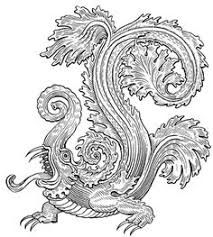Makara: Exploring Sri Lankan Origins of the Mythical Beast
- gem_head

- Mar 28, 2020
- 3 min read
Updated: Mar 30, 2020
Earlier this week I participated in a fabulously informative webinar on David Webb Jewelry Archives, organized by the GemX Club, featuring Levi Higgs - the very talented jewelry historian and archivist at David Webb. One of the iconic David Webb jewels highlighted during the presentation was the ‘Makara’ bracelet designed for the legendary Elizabeth Taylor, the very first animal bracelet David Webb ever made in 1964.

My self among other webinar attendees were curious as to what the ‘Makara’ was. As a Sri Lankan, I was familiar with the word/term - it’s the creature seen at buddhist temple entrances.
What exactly is a ‘Makara’ and why incorporate it in jewelry?
After a quick google search, I spoke with Buddhist Historian and Author from Sri Lanka, Das Miriyagalla for his insights.
As per my google search, ‘Makara’ or ‘Makar’ is a variation, or ‘type’ of Dragon. There’s a whole list of different types and names of Dragons on wikipedia divided by region of origin. For instance in Chinese mythology they refer to the Dragon as Lóng, and several variations of dragons are mentioned i.e. Gonggong - a water dragon and Fucanglong - dragon of volcanic element to name a few. In Tibetan and Bhutanese mythology, Dragon is Druk. The Bhutanese refer to their nation as 'Druk Yul'; translation 'Land of Dragon': there's a dragon on their national flag and the national airline is ' Druk Air'. In Cambodia and Vietnam it seems they referred to Dragon, (or at least a variation of Dragon) as ‘Makar’. And in Sri Lanka and South India, the creature is referred to as ‘Makara’. Sri Lankans are supposed have believed Makara was composed of body parts of several other animals i.e. head of an elephant, body of fish, ears of an ape, tail of a crocodile, horns of a goat.
Miriyagalla had fascinating insights to share, he pointed out three instances where the ‘Makara’ plays a role in Asian/Buddhist culture:
1. As guardians of places of importance: In Sri Lanka, Makara is seen at entrances of temples along with gargoyles, as protectors against harm or disaster. It is fairly reasonable to assume that the Makara is thought of as a protector of important places in Sri Lanka similar to how the dragon was associated as a guardian of treasures and castles in Western mythology. Makara was probably adapted to early Sri Lankan architecture and mythology as a buddhist tradition, also shared among other East Asian countries practicing Buddhism i.e. India, China, Japan, Cambodia, Thailand, Vietnam, Burma, Nepal etc.
2. Zodiac Sign Capricornus: Astrologists derive the 12 signs of Zodiac from 12 constellations of stars. The constellation of stars of Zodiac Capricornus in Sinhalese (Sri Lankan language) is ‘Makara’. This Makara/Capricornus Zodiac sign is illustrated with head of a ram goat and lower part of body of a fish. Capricornus constellation has about 7 visible stars which are connected to form an imaginary Makara.
3. Tropic of Capricorn (Globally recognized , not limited to Asia/Sri Lanka): During the peak of winter (December 21), the sun sun appears to move at the southern most point called Tropic of Capricorn. The Northern most point is the Tropic of Cancer.
Sri Lankan translation for ‘Tropic of Capricorn’ is 'Makara Nivartanaya’ (nivarthanaya meaning stopping point). The movement of sun over 12 months takes place between the above two tropics. All countries between these two tropics are known as tropical counties i.e. Sri Lanka.

In Sri Lanka, men and women are known to have worn amulets/medallions with Makara symbols as they believed it to be a guardian or protector. 'Kastane' - a short traditional ceremonial/decorative single-edged Sri Lankan sword was widely decorated with a Makara head handle through the 19th Century. Much like the Mughal kings and maharajas, Sri Lankan kings and royals are known to have incorporated Makara in their jewels.
Although I am not fully certain, I believe some Sri Lankan brides incorporate a Makara pendent in their bridal jewelry even today - I've heard of this, but unable to confirm. There are also indications that followers of astrology, especially those belonging to the house fo Capricorn wear jewelry with Makara symbols as talisman.
I can’t speak as to David Webb’s inspiration to incorporate the Makara in his designs, however happy to see this creature being popularized in the West, keeping its legend alive.
Resources:
A PAIR OF ANTIQUE ENAMEL, DIAMOND AND RUBYKADAS (Image). (2020, march 28) Retrieved from https://www.christies.com/lotfinder/Jewelry/a-pair-of-antique-enamel-diamond-and-6211897-details.aspx?lid=1&from=relatedlot&intobjectid=621189
Kastane. (2020, March 26). Retrieved from https://en.wikipedia.org/wiki/Kastane
List of dragons in mythology and folklore (2020, March 26). Retrieved from https://en.wikipedia.org/wiki/List_of_dragons_in_mythology_and_folklore
Makara. (2020, March 26). Retrieved from https://en.wikipedia.org/wiki/Makara
Makara Bracelet by Daid Webb (Image). (2020, March 26). Retrieved from https://www.pinterest.com/pin/528187862522832342/
Miriyagalla, D. (2020, March 26). Personal Interview
. (n.d.). Retrieved from http://karava.org/royal_symbols/weapons
. (n.d.). Retrieved from https://www.rct.uk/collection/11310



















Comments